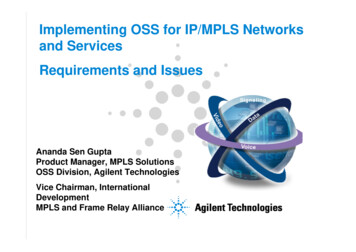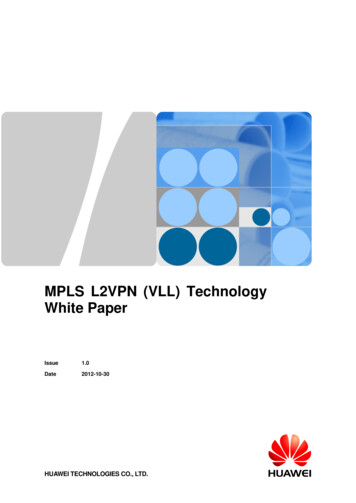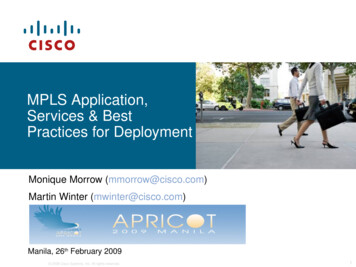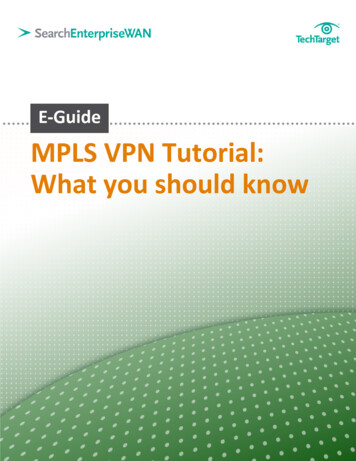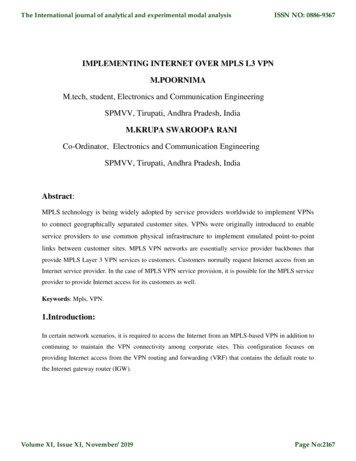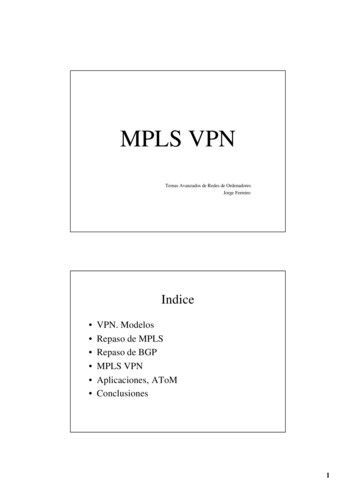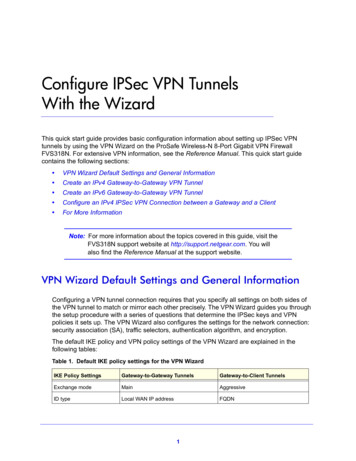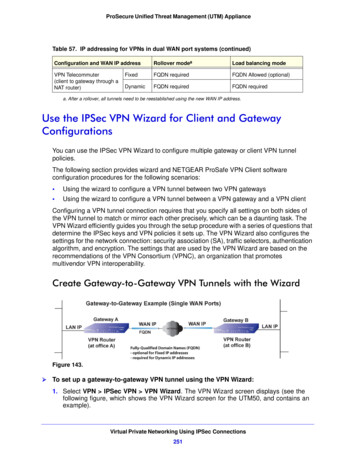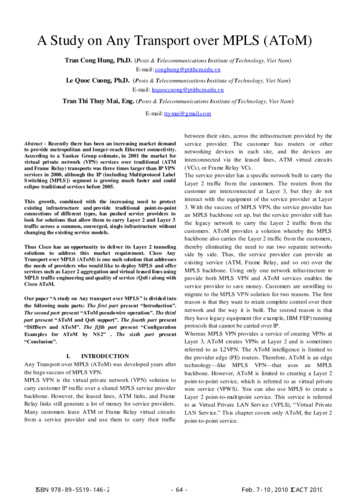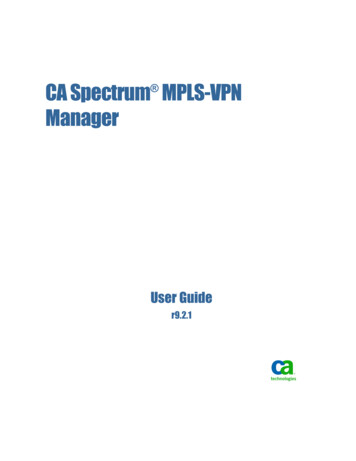
Transcription
CA Spectrum MPLS-VPNManager User Guider9.2.1
This documentation, which includes embedded help systems and electronically distributed materials, (hereinafterreferred to as the ―Documentation‖) is for your informational purposes only and is subject to change or withdrawal byCA at any time.This Documentation may not be copied, transferred, reproduced, disclosed, modified or duplicated, in whole or in part,without the prior written consent of CA. This Documentation is confidential and proprietary information of CA and maynot be disclosed by you or used for any purpose other than as may be permitted in (i) a separate agreement betweenyou and CA governing your use of the CA software to which the Documentation relates; or (ii) a separateconfidentiality agreement between you and CA.Notwithstanding the foregoing, if you are a licensed user of the software product(s) addressed in the Documentation,you may print or otherwise make available a reasonable number of copies of the Documentation for internal use byyou and your employees in connection with that software, provided that all CA copyright notices and legends areaffixed to each reproduced copy.The right to print or otherwise make available copies of the Documentation is limited to the period during which theapplicable license for such software remains in full force and effect. Should the license terminate for any reason, it isyour responsibility to certify in writing to CA that all copies and partial copies of the Documentation have beenreturned to CA or destroyed.TO THE EXTENT PERMITTED BY APPLICABLE LAW, CA PROVIDES THIS DOCUMENTATION ―AS IS‖ WITHOUTWARRANTY OF ANY KIND, INCLUDING WITHOUT LIMITATION, ANY IMPLIED WARRANTIES OF MERCHANTABILITY,FITNESS FOR A PARTICULAR PURPOSE, OR NONINFRINGEMENT. IN NO EVENT WILL CA BE LIABLE TO YOU OR ANYTHIRD PARTY FOR ANY LOSS OR DAMAGE, DIRECT OR INDIRECT, FROM THE USE OF THIS DOCUMENTATION,INCLUDING WITHOUT LIMITATION, LOST PROFITS, LOST INVESTMENT, BUSINESS INTERRUPTION, GOODWILL, ORLOST DATA, EVEN IF CA IS EXPRESSLY ADVISED IN ADVANCE OF THE POSSIBILITY OF SUCH LOSS OR DAMAGE.The use of any software product referenced in the Documentation is governed by the applicable license agreement andsuch license agreement is not modified in any way by the terms of this notice.The manufacturer of this Documentation is CA.Provided with ―Restricted Rights.‖ Use, duplication or disclosure by the United States Government is subject to therestrictions set forth in FAR Sections 12.212, 52.227-14, and 52.227-19(c)(1) - (2) and DFARS Section252.227-7014(b)(3), as applicable, or their successors.Copyright 2011 CA. All rights reserved. All trademarks, trade names, service marks, and logos referenced hereinbelong to their respective companies.
CA Technologies Product ReferencesThis document references the following CA Technologies products: CA Spectrum Infrastructure Manager (CA Spectrum) CA Spectrum Report Manager (Report Manager) CA Spectrum IP Routing Manager CA Spectrum Service Performance Manager (SPM) CA Business Intelligence (CABI)Contact CA TechnologiesContact CA SupportFor your convenience, CA Technologies provides one site where you can accessthe information you need for your Home Office, Small Business, and EnterpriseCA Technologies products. At http://ca.com/support, you can access thefollowing: Online and telephone contact information for technical assistance andcustomer services Information about user communities and forums Product and documentation downloads CA Support policies and guidelines Other helpful resources appropriate for your productProvide FeedbackIf you have comments or questions about CA Technologies productdocumentation, you can send a message to techpubs@ca.com.If you would like to provide feedback about CA Technologies productdocumentation, complete our short customer survey, which is available on theCA Support website at http://ca.com/docs.
ContentsChapter 1: Introduction7Overview . 7VPN Topologies Supported . 7Overlapping VPN Considerations and Limitations . 8MIB Support and Device Compatibility . 9Chapter 2: MPLS VPN Manager Interface11Open MPLS VPN Manager . 11MPLS VPN Manager Hierarchy . 12Search VPNs . 13Chapter 3: Discovery and Modeling15Discovery Prerequisites . 15Configure VPN Discovery Options . 16IfExclusionList . 17Update VPN Models for Overlapping VPN Topology . 17Run VPN Discovery . 18Configuring VPN Discovery During Modeling . 18Run VPN Discovery on Selected Models . 19Model Types. 19VPN Site Names . 21VPN Site Model Deletion. 21Chapter 4: Configuring MPLS VPN Manager23Distributed SpectroSERVER Configuration . 23VPN Manager Configuration . 24Configure Port Polling . 24Control Default Model Priority . 25Configure Trap Options . 26Configure VRF Ping . 26Configure VRF Path Trace . 28Global Configurations and Local Overrides . 30VPN Model Configuration . 31Configuring VPN Condition Alarms . 32VPN Site Model Configuration . 33Configure VRF Path Trace Source and Destination . 34Contents 5
Configure VRF Ping Source and Destination . 35Chapter 5: Managing VPNs37The VPN Manager Model . 37The VPN Model . 37General Information . 38Configuration Information . 38Route Statistics . 39Associated Sites . 39Associated Edge Routers . 39The VPN Site Model . 39General Information . 39VRF Path Trace History . 40BGP Statistics . 41Associated Edge Routers . 41VPN and VPN Site Performance . 42Spotlighting VPNs . 42Checking the Status of VPN Paths with VRF Path Tracing . 43Background Path Monitoring . 43On-Demand Path Monitoring . 44Calculating the Condition of a VPN . 44Calculating the VPN Condition using VRF Ping . 45Calculating the VPN Condition using the VPN Site Condition . 46Trap Support . 48Automatically Creating and Deleting VPN Sites . 49Threshold Traps . 49Chapter 6: Troubleshooting51Index536 User Guide
Chapter 1: IntroductionThis section contains the following topics:Overview (see page 7)VPN Topologies Supported (see page 7)MIB Support and Device Compatibility (see page 9)OverviewMPLS VPN Manager lets you discover, model, and monitor Virtual PrivateNetworks (VPNs) within the network environment. MPLS VPN Manager providesVPN and Site discovery and modeling, VPN connectivity status, SNMP traphandling, monitoring of Virtual Routing and Forwarding (VRF) conditions, andperforms calculation of and alarming on VPN conditions. MPLS VPN Manager is adistributed application.MPLS VPN Manager discovers all of the Provider Edge (PE) routers and interfacesthat are forwarding traffic for a particular VPN. Based on this discovery, CASpectrum creates VPN models representing each unique VPN. These VPN modelscan then be polled for their current operational status (Up or Down).In addition, MPLS VPN Manager supports VRF Ping and VRF Path Tracing, whichenables you to monitor the status of the paths between the sites in each of themodeled VPNs.You can configure threshold alarms to alert you when pathchanges exceed the configured tolerance.MPLS VPN Manager provides searches that let you quickly find a particular VPN orall VPNs. Search results contain a list of the current VPNs configured within theenvironment and their current status. You can drill into a single VPN to see thecurrent list of PE interfaces participating within that VPN as well as the currentstatus of the VPN.VPN Topologies SupportedThe common topologies for MPLS Layer 3 VPNs include Full Mesh, Hub andSpoke, and Overlapping VPNs. MPLS VPN Manager supports the following twotopologies: Full Mesh—The service provider provisions the service so that all customersites communicate directly with each other. Customer sites are members ofthe same single VPN. This topology is the most common VPN topologies, andit is generally used by enterprise customers to establish their corporateintranet.Chapter 1: Introduction 7
VPN Topologies Supported Overlapping VPNs—Sites can be members of multiple VPNs. Scenariosrequiring sites with multiple memberships include the following:–Establishing a management VPN to customer edge devices–Establishing a shared service across VPNs–Implementing an extranet-based serviceOverlapping VPN Considerations and LimitationsFor overlapping VPN topologies, consider the following notes and limitationswhen using MPLS VPN Manager:8 User Guide Configurations based on route-map statements are not reflected in themplsVpnVrfRouteTargetTable. CA Spectrum does not discover or modelthese configurations. The scale of Service Assurance tests in overlapping VPNs becomes morecritical because of the greater possibility that connectivity spans multipleVPNs. We recommended enabling Service Assurance tests incrementally toevaluate the performance and resource impacts. VPN Sites impact the health of all VPNs in which it has membership. A singleVPN Site outage can cause the generation of several alarms (that is, onealarm for each VPN in which the VPN Site has membership). CA Spectrumdoes not correlate (that is, suppress) the alarms. Areas affected include:–VPN condition calculation–VRF test results–Aggregate VPN performance (bandwidth usage added to each VPN) There is no mechanism to detect when new Route Targets are added,removed, or modified in existing VPNs. There is no background discoverymechanism, and this information is not captured by traps. When VPN Sites read some of their configuration from their parent VPN,unexpected behavior can occur when VPN Sites are in multiple VPNs.Configure VPNs similarly for the following options:–Enable VRF ping and trace–Enable site alarms–Model security
MIB Support and Device CompatibilityMIB Support and Device CompatibilityThe MPLS VPN Manager currently supports the IETF draft MPLS/BGP VPN MIB(draft-ietf-ppvpn-mpls-vpn-mib-05) and Cisco's MPLS Virtual Private NetworksMIB (MPLS-VPN-MIB). Cisco's MPLS-VPN-MIB is based on Draft 3 of the IETFdraft MPLS/BGP VPN MIB.These MIBs provide access to the following configuration information for VPNsconfigured on PE router interfaces: Virtual Routing/Forwarding (VRF) Instance Table (mplsVpnVrf) - Containsthe VPN name and the Route Descriptors (RD) for each VRF. VPN Interface Configuration Table (mplsVpnInterfaceConf) - Associatesentries in the ifTable with a VRF.MPLS VPN Manager uses the following MIBs to support the VRF Ping and the VRFTrace functionality: Cisco- RTTMON MIB Juniper- RFC2925, Juniper Ping MIB, and Juniper Traceroute MIBMPLS VPN Manager also supports the following tables in the Juniper EnterpriseVPN MIB: Table of Configured VPNs (jnxVpnTable) Table of VPN Interfaces (jnxVpnIfTable)In addition, MPLS VPN Manager provides partial support for the Draft 4 of theIETF MPLS/BGP VPN MIB.MPLS VPN Manager functionality is supported by Cisco GSR 12000 and 7500Series routers running Cisco IOS 12.2(15) T8 or higher in networks with properlyconfigured MPLS VPNs. Juniper support is for JunOS 6.1 or later.Chapter 1: Introduction 9
Chapter 2: MPLS VPN Manager InterfaceThis section contains the following topics:Open MPLS VPN Manager (see page 11)MPLS VPN Manager Hierarchy (see page 12)Search VPNs (see page 13)Open MPLS VPN ManagerTo view the VPNs modeled in your networking environment, open MPLS VPNManager in OneClick.To open MPLS VPN Manager in OneClick1. Open OneClick.2. Click the VPN Manager node on the Explorer tab in the Navigation panel.MPLS VPN Manager opens, and the Contents panel populates withinformation about the selected VPN Manager.Chapter 2: MPLS VPN Manager Interface 11
MPLS VPN Manager HierarchyMPLS VPN Manager HierarchyMPLS VPN Manager can be directly accessed from the Explorer tab of theNavigation panel. Expanding the VPN Manager node displays all of the VPNsmanaged by the MPLS VPN Manager. Expanding each VPN displays the VPN Sitescontained in the VPN.Note: Each VPN Site displays under the VPN in which it has membership. In anoverlapping VPN topology, a specific VPN Site may show up under multiple VPNs.The following graphic is an example of the MPLS VPN Manager hierarchy in theNavigation panel:12 User Guide
Search VPNsThe Contents panel displays the Alarm list for the modeled element that youhave selected in the Navigation panel. The Component Detail panel displays theAlarm details for the Alarm selected in the Alarm list shown in the Contentspanel. If the Alarm list is empty, the Component Detail panel displays theInformation view for the modeled element selected in the Navigation panel.Search VPNsThe Locater tab includes specific searches for VPNs. These searches supportcross-server device modeling. You can specify one, a few, or all SpectroSERVERsto search for a particular MPLS VPN Manager model, sets of VPNs, or VPN Sitesthat are managed by a specific SpectroSERVER. You can use the search results toaccess a number of views that present management, performance, andconfiguration information.To search your MPLS VPN Manager environment1. Open OneClick.2. Click the Locater tab in the Navigation panel.3. Expand the VPN node and double-click the type of search you want toconduct.The Select Landscapes to Search dialog opens.4. Select the Landscapes you want to include in your search and click OK.The search results appear in the Contents panel.More information:VPN Manager Configuration (see page 24)Configuring VPN Condition Alarms (see page 32)Configure VRF Path Trace Source and Destination (see page 34)Configure VRF Ping Source and Destination (see page 35)Chapter 2: MPLS VPN Manager Interface 13
Chapter 3: Discovery and ModelingBefore you can use MPLS VPN Manager to manage the VPNs on your network,you must run VPN Discovery. VPN Discovery discovers each VPN and VPN Sitecurrently configured on devices modeled in CA Spectrum.This section contains the following topics:Discovery Prerequisites (see page 15)Configure VPN Discovery Options (see page 16)Update VPN Models for Overlapping VPN Topology (see page 17)Run VPN Discovery (see page 18)Model Types (see page 19)VPN Site Names (see page 21)VPN Site Model Deletion (see page 21)Discovery PrerequisitesFor VPN Discovery to complete successfully, devices must meet the followingprerequisites: VPN devices must support the correct MPLS-VPN MIBs. You must model the physical components of your network in CA Spectrumbefore using the VPN Discovery functionality. You can model the physicalcomponents using one of these methods: Discovery, manual modeling, orthe Modeling Gateway.Note: For instructions about using these mechanisms to model yournetwork, see the Modeling and Managing Your IT InfrastructureAdministrator Guide and the Modeling Gateway Toolkit Guide. The devices must have MPLS-VPN properly configured.More information:MIB Support and Device Compatibility (see page 9)Chapter 3: Discovery and Modeling 15
Configure VPN Discovery OptionsConfigure VPN Discovery OptionsBefore modeling your MPLS VPN Manager environment, you can select severalVPN Discovery options. These options determine how CA Spectrum finds andmodels the VPNs in your environment.To configure the VPN Discovery options1. Open MPLS VPN Manager (see page 11).MPLS VPN Manager opens, and the Contents panel populates withinformation about the selected VPN Manager.2. Click the Information tab.3. Expand the Configuration, VPN Discovery subview.4. Click set in the following fields to select your configuration settings:Model Inactive VPNsDetermines whether inactive VPNs in your network environment arediscovered and modeled by VPN Discovery.Default: NoEnable Dynamic DiscoveryDetermines whether to start the VPN Discovery automatically when anew PE router is modeled. Starting VPN Discovery automatically helps tokeep the VPN information current when new devices are added to thenetwork.Note: As the MPLS VPN Manager application is running, VPN sites maybe created or destroyed when certain traps are received.Default: NoUse RD instead of VRF nameDetermines whether to use the VRF name or Route Distinguisherinformation from the MIB as the unique identifier when determining VPNmembership. This information is used when discovering and namingyour VPN site models. By default, CA Spectrum uses the VRF name.However, if your routers use different VRF names for the same VPN routetarget, CA Spectrum creates a separate VPN site model for each newname. In this case, you can avoid multiple models for the same VPN siteby configuring CA Spectrum to use the Route Distinguisher (RD) fromthe MIB to model your VPN sites.Default: No16 User Guide
Update VPN Models for Overlapping VPN TopologyVRF/RD Name Filter TypeDetermines if the VRF/RD names in the 'Global VRF/RD Name Filter' fieldare included or excluded from modeling. This feature can saveunnecessary resources by limiting the number of VPN sites that requiremonitoring. Options include the following: Exclusive InclusiveGlobal VRF/RD Name FilterSpecifies the VRF/RD names to be included or excluded from modeling.This field is used together with the 'VRF/RD Name Filter Type' field.Your VPN Discovery options are configured.More information:Automatically Creating and Deleting VPN Sites (see page 49)IfExclusionListIfExclusionList is an attribute of the VpnManager (attribute ID: 0x4940185) andis not listed with the VPN Discovery configuration options. This attribute is a textattribute with the default value of 24,131. This value means that by default MPLSVPN Manager does not create VpnSite models for loopback interfaces(ifType 24) and tunnel interfaces (ifType 131).This attribute can be modified to include additional interface types by using theAttribute Editor in OneClick and adding IfExclusionList as a User Definedattribute.Update VPN Models for Overlapping VPN TopologyVPN models created prior to CA Spectrum Release 9.2.1 do not supportoverlapping VPN topology. CA Spectrum does not automatically update existingVPN models to support overlapping VPNs. To properly manage your overlappingVPNs in CA Spectrum, you must manually migrate the existing VPN models.To update VPN models to use overlapping VPN topology1. Open MPLS VPN Manager (see page 11).MPLS VPN Manager opens, and the Contents panel populates withinformation about the selected VPN Manager.2. Click the List tab.The table lists all existing VPN models.Chapter 3: Discovery and Modeling 17
Run VPN Discovery3. Select all VPN models, right-click, and select Delete.CA Spectrum deletes all VPN models and their associated VPN Site models.4. Run VPN Discovery (see page 18).CA Spectrum updates your VPN models by recreating the VPN models. Thesenew models support overlapping VPN topologies.Run VPN DiscoveryVPN Discovery is the simplest method of modeling your network. Before runningan on-demand VPN Discovery, you must meet the prerequisites.Important! Before running VPN Discovery, be sure all Provider Edge devices aremodeled in CA Spectrum with the read/write community name. MPLS VPNManager cannot locate your VPNs without these Provider Edge models in theSpectroSERVER.To run VPN Discovery1. Open MPLS VPN Manager (see page 11).MPLS VPN Manager opens, and the Contents panel populates withinformation about the selected VPN Manager.2. Click the Information tab.3. Expand the Configuration, VPN Discovery subview.VPN Discovery options and configurations display.4. Click Run.The Select Landscapes dialog opens.5. Select the landscapes on which you want to run VPN Discovery and click OK.VPN Discovery runs.Note: When discovering VPNs on a single SpectroSERVER, the VPNDiscovery field status indicator displays the number of MPLS-VPN devicesdiscovered. For multiple SpectroSERVERs, the VPN Discovery field statusindicator displays the number of servers discovered.Configuring VPN Discovery During ModelingCA Spectrum lets you configure Network Services Discoveries, including VPNDiscovery, during modeling. As a part of modeling configuration, you can specifywhich Network Service Discoveries to run with the modeling process.Note: For more information, see the Modeling and Managing Your ITInfrastructure Administrator Guide.18 User Guide
Model TypesRun VPN Discovery on Selected ModelsVPN Discovery is one of the Network Services Discovery options, which areavailable for models in various OneClick views. Instead of modeling all VPNs inyour networking environment, this option lets you quickly model VPNs that arerelated to selected models in your networking environment.To run VPN Network Services Discovery on selected models1. Open OneClick.2. Select device models related to your VPN environment.3. Right-click the models and select Tools, Utilities, Network ServicesDiscoveries, VPN Discovery.The VPN Discovery process is initiated for the selected models only. You cancheck the status in the Configuration, VPN Discovery subview for MPLS VPNManager.Model TypesCA Spectrum creates several model types during VPN Discovery to representdifferent aspects of the MPLS/BGP VPN MIB in MPLS VPN Manager.The MPLS VPN Manager model types include the following:VPN ManagerRepresents the MPLS VPN Manager component installed with CA Spectrumthat manages your VPN networking environment. The CA Spectrum modeltype for MPLS VPN Manager is VpnManager. This model cannot be destroyed.VPN SiteRepresents each unique VPN Site that CA Spectrum discovers during VPNDiscovery. CA Spectrum creates the VPN Site model on the sameSpectroSERVER as its associated PE Router. The Model Class attribute for theVPN Site model is set to Transport Service. The CA Spectrum model type isVpnSite.Note: MPLS VPN Manager assumes that each VPN Site is connected to agiven PE by a single interface. By default, CA Spectrum does not createVpnSite models for loopback and tunnel interfaces.VPN ApplicationRepresents a modeled device that supports the appropriate MPLS-VPN MIB.This application model must be present for VPN Discovery to successfullydiscover MPLS-VPN information. The CA Spectrum model types areMplsVpnApp (for Cisco devices) and JNPR VPN App (for Juniper devices).The Model Class attribute is set to Application for these models.Chapter 3: Discovery and Modeling 19
Model TypesVPNRepresents each unique VPN that CA Spectrum models. The Model Classattribute for the VPN model is set to Transport Services. The CA Spectrummodel type is MplsVpn.Route TargetRepresents the Import and Export of Route Targets. Models of this type donot display in the Navigation view. Instead, they are created on the MainLocation Server (MLS). The following diagram shows the Route TargetModels created for an overlapping VPN topology scenario:20 User Guide
VPN Site NamesVPN Site NamesCA Spectrum generates unique names for VPN Sites during Discovery based onthe PE model name, VPN name, and IfName of the interface to which the VPNSite is connected. Using these values helps ensure the VPN Site names in CASpectrum are unique.The VPN Site name follows this structure:ModelName VPNname IfNameModelNameRepresents the name of the PE Router model to which the VPN Site isconnected.Example: 172.19.38.40VPNnameRepresents the name of the VPN to which the VPN Site is connected.Example: vpn-blueIfNameRepresents the IfName of the interface to which the VPN Site is connected.Example: VPN Site nameCA Spectrum creates the following VPN Site name when the VPN Site isconnected to a VPN named "vpn-blue," a PE Router model named"172.19.38.40," and the interface IfName value is "Fa2/0":172.19.38.40 vpn-blue Fa2/0VPN Site Model DeletionA VPN Site model can be deleted in any of the following ways: VPN Site models can be manually deleted from the Explorer tab. VPN Site models automatically delete when the associated VPN model orProvider Edge (PE) Router model is deleted.Note: When a VPN is deleted in an overlapping VPN environment, CASpectrum cannot delete the associated VPN Sites with multiplememberships. CA Spectrum deletes a VPN Site with multiple membershipsonly when the last VPN referencing the site is deleted.Chapter 3: Discovery and Modeling 21
VPN Site Model Deletion22 User Guide VPN models automatically delete when all associated VPN Site models aredeleted. VPN Site models automatically delete when CA Spectrum receives anmplsVrfIfDown SNMP trap from the associated PE Router model and thesame VRF entry was removed from the PE Router's VRF Table.
Chapter 4: Configuring MPLS VPNManagerAfter VPN Discovery, you can configure MPLS VPN Manager to manage the VPNenvironment effectively. MPLS VPN Manager provides configuration options forVPN Manager models, the individual VPN models, and for VPN Site models, asfollows: The VPN Manager model configuration lets you specify parameters for all ofthe VPNs managed by the specified VPN Manager. You can configure VRFPing and VRF Trace parameters that check on the connectivity of the VPNs inyour network and you can configure other parameters relating to how trapsand alarms are processed. VPN configuration parameters let you set threshold values and other alarmspecifics for the VPN Sites within that VPN. VPN Site configuration lets you set Trace Mode and Ping Mode, whichdetermine how VRF Path Tracing and VRF Ping should operate within theVPN.This section describes how to access and set configuration options for MPLS VPNManager.This section contains the following topics:Distributed SpectroSERVER Configuration (see page 23)VPN Manager Configuration (see page 24)VPN Model Configuration (see page 31)VPN Site Model Configuration (see page 33)Distributed SpectroSERVER ConfigurationIn a distributed SpectroSERVER (DSS) environment, you can model your PERouters from any SpectroSERVER. A VPN Site model is created on theSpectroSERVER that its associated PE Router is modeled on. All of the discoveredVPNs appear in the VPN Manager area of the OneClick Console. You can enablecross-server Path Tracing and Ping tests to determine the condition of the VPNsthat you are managing. The local SpectroSERVERs must have a connection to theMain Location Server (MLS) to support this distributed configuration.Important! An implementation requirement of the distributed VPN Manager isthat all MplsVpn models must reside on the SpectroSERVER that is on the MLSmachine. When you change the MLS, the MplsVpn and VpnSite models becomeinvalid and are deleted by each SpectroSERVER in the DSS environment.Chapter 4: Configuring MPLS VPN Manager 23
VPN Manager ConfigurationNote: For more information about changing the MLS, see the procedures in theDistributed SpectroSERVER Administrator Guide.VPN Manager ConfigurationThe VPN Manager model manages a set of VPNs on a given CA Spectrumlandscape. The following options are controlled by the VPN Manager model: Port polling Default model priority Traps VRF pinging VRF path tracingMore information:Search VPNs (see page 13
MPLS VPN Manager also supports the following tables in the Juniper Enterprise VPN MIB: Table of Configured VPNs (jnxVpnTable) Table of VPN Interfaces (jnxVpnIfTable) In addition, MPLS VPN Manager provides partial support for the Draft 4 of the IETF MPLS/BGP VPN MIB. MPLS VPN Manager functionality is supported by Cisco GSR 12000 and 7500
